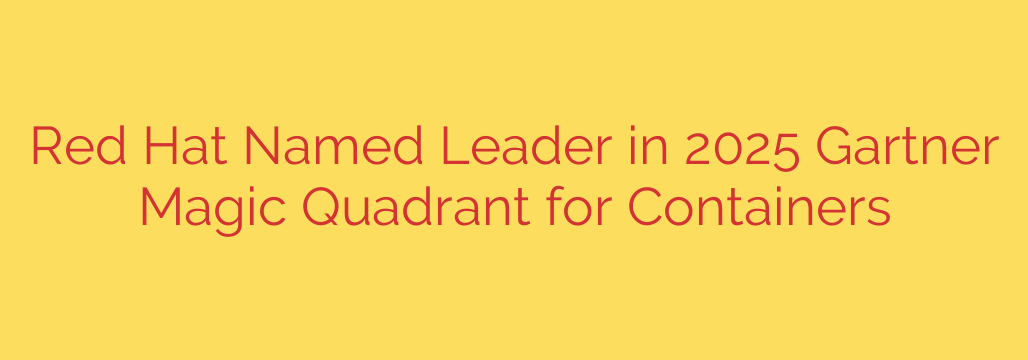
Why Red Hat Was Named a Leader in the 2025 Gartner® Magic Quadrant™ for Container Platforms
In the fast-paced world of cloud-native technology, enterprise-grade container platforms have become the bedrock of modern application development and deployment. For organizations navigating this complex landscape, expert analysis is crucial. That’s why the latest Gartner® Magic Quadrant™ for Container Platforms is a significant event, and Red Hat’s consistent placement as a Leader underscores its pivotal role in the industry.
This recognition is not just about a single product; it reflects a deep understanding of enterprise needs, a forward-thinking vision, and a proven ability to execute on that vision. For IT leaders, developers, and security professionals, this analysis provides a clear signal about the stability, innovation, and reliability of Red Hat’s container solutions.
Understanding the Core Strengths: Vision and Execution
The Gartner Magic Quadrant evaluates vendors on two primary axes: “Completeness of Vision” and “Ability to Execute.” Excelling in both is what separates a Leader from the rest of the pack.
Red Hat’s position is a testament to its strength in both areas, driven largely by its flagship platform, Red Hat OpenShift.
Completeness of Vision: This metric assesses a vendor’s understanding of market trends and its strategy for the future. Red Hat continues to excel here by focusing on the core challenges of modern IT. Its vision is built around a unified hybrid and multi-cloud strategy, allowing businesses to run applications anywhere—from on-premise data centers to multiple public clouds—without being locked into a single provider. The platform’s deep integration of AI/ML workloads, serverless computing, and advanced developer tools demonstrates a clear roadmap for the future of enterprise software.
Ability to Execute: A great vision means little without the ability to deliver. Red Hat’s strength in execution is rooted in its enterprise-grade, security-focused Kubernetes platform. Red Hat OpenShift provides the robust, scalable, and secure foundation that large organizations require to run their most critical applications in production. With a massive global support network, a vast partner ecosystem, and a proven track record across nearly every industry, Red Hat has demonstrated its ability to help customers succeed at scale.
What This Means for Your Business
The recognition of Red Hat as a Leader is more than an accolade; it has tangible implications for businesses building their cloud-native strategy.
Reduced Complexity and Increased Consistency: Managing applications across different environments is a major challenge. Red Hat OpenShift provides a single, consistent platform for building, deploying, and managing containers, regardless of the underlying infrastructure. This simplifies operations, reduces training overhead, and accelerates development cycles.
Enhanced Developer Productivity: Modern development requires more than just a container orchestrator. OpenShift is a complete application platform that comes with integrated CI/CD pipelines, service mesh, and serverless capabilities. This comprehensive toolset empowers developers to focus on writing code and delivering value, rather than managing complex infrastructure.
Enterprise-Ready Security: Security cannot be an afterthought in the container world. Red Hat has built robust security features directly into the platform’s foundation. From trusted container registries and integrated scanning to fine-grained access control and network policies, OpenShift provides a DevSecOps framework that helps secure the entire application lifecycle.
Actionable Security Tips for Your Container Strategy
Whether you are already using containers or just starting your journey, leveraging a leading platform is only part of the equation. Here are key security practices to implement:
Implement a “Shift-Left” Security Model: Integrate security scanning and vulnerability management directly into your CI/CD pipeline. By catching potential issues early in the development process, you can significantly reduce risk and avoid costly fixes later. Platforms like OpenShift provide the tools to automate this process.
Use Trusted and Signed Container Images: Ensure your applications are built from a foundation of trusted, certified base images. Utilize private registries to manage your organization’s images and enforce policies that prevent the deployment of unverified or vulnerable containers.
Enforce the Principle of Least Privilege: Use role-based access control (RBAC) to precisely define who can do what within your Kubernetes clusters. Limit container permissions so they only have access to the resources they absolutely need to function. This minimizes the potential impact of a security breach.
In conclusion, the consistent recognition of Red Hat as a Leader in the container platform market highlights its commitment to open-source innovation, enterprise stability, and a customer-centric vision. For organizations looking to modernize their applications and embrace the power of the hybrid cloud, this analysis confirms that Red Hat OpenShift remains a powerful and strategic choice.
Source: https://datacenternews.asia/story/red-hat-named-leader-in-2025-gartner-magic-quadrant-for-containers








